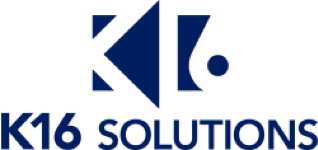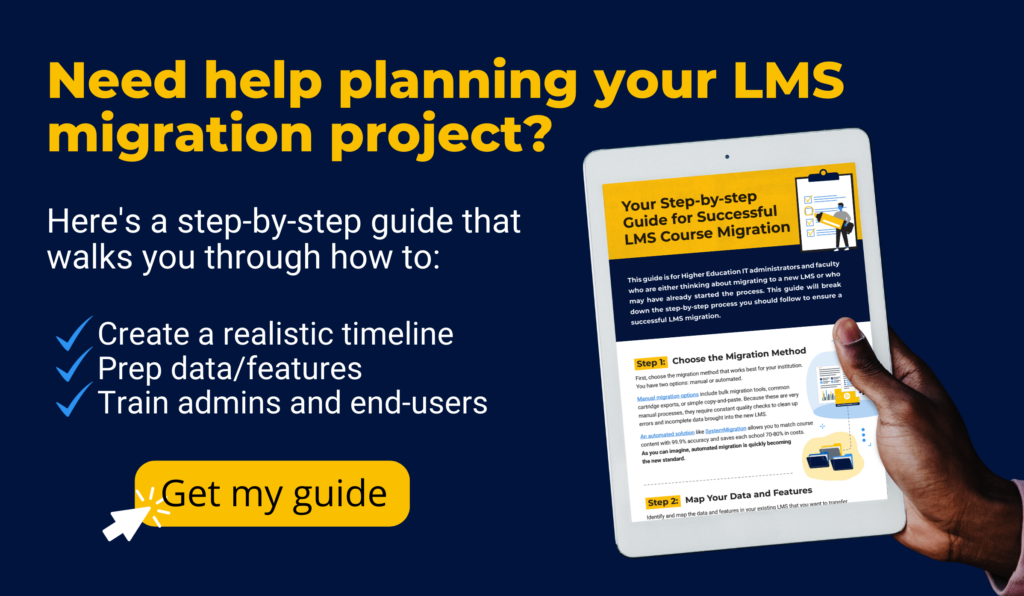Everything You Need to Know about LMS Migration – FAQs & Tips
Is your institution planning or currently in the process of an LMS migration project?
Migrating to a new LMS can seem overwhelming or even daunting. That’s why we put together this guide to answer any questions you could have about the process, including FAQs and tips.
What is automated LMS migration?
To answer this question, let’s first talk about manual LMS migration. For decades, the only way to transfer to a new LMS was by manually copying and pasting each course. This process was lengthy, cumbersome, and error-prone.
Common cartridge exports and bulk migration are newer options, but they still require manual copying and pasting of courses.
An automated solution like Scaffold Migration allows you to match all content from one LMS to another. This simple but sophisticated service easily transfers course content regardless of type without any copying and pasting.
Automated migration VS. manual – Which is better?

Sometimes the lower upfront cost of manual migration can seem appealing, but these solutions often cost more by the end of the project in more ways than one.
For example, since manual migration requires copying and pasting to move much of the content to the new platform, faculty will often be required to work overtime to move their courses over. This unnecessary stress contributes to faculty burnout and dissatisfaction.
Many schools opt for hiring a white glove service or instructional designers to help with this process, but that still means that humans copy and paste the content, leaving more room for errors or missing content.
For all these reasons, automated migration is quickly becoming the standard way to migrate to a new LMS.
How much does LMS migration actually cost?
An automated solution like Scaffold LMS Migration generally costs anywhere from $65-99 a course for the first 1,000 transferred over and then $25-75 per additional course, depending on several factors. See how this cost compares to other solutions.
How long does an LMS migration project really take?
The short answer ranges from 90 days to several years, depending on your migration method. An automated solution can take 90-120 days, while a manual solution can take months or years depending on how many courses you need to migrate. Take a look at some typical migration timelines to help you plan yours.
Do you have to leave custom developments behind when you migrate?
With old-school migration methods, you will inevitably lose most, if not all, custom developments when you migrate. Many institutions will avoid migration for this reason–that data is too precious to lose!
But not with Scaffold LMS Migration. Its one-to-one matching system allows you to easily transfer data, including:
- Quizzes and quiz banks
- Vocab lists
- Script tags
- iFrame
- LTI’s
- And more
In short, you do not have to leave custom developments behind when you migrate.
What should I do with historical content in the legacy LMS?
When you decide to migrate to a new LMS, one important decision you’ll face is what you’ll do with important historical data. You can’t afford to get rid of this precious data. Grade challenges can happen up to years after a student has graduated, not to mention you’ve been collecting other important information for years, and you can’t just delete it all.
That’s why so many institutions opt to continue paying their legacy LMS to hold onto historical content. Unfortunately, this choice is expensive. It can cost up to $5-20k per month–that’s potentially hundreds of thousands of dollars per year. Cold storage is another option, but
Migrating to a new LMS is the best time to create a more efficient student data archiving strategy. Scaffold Archiving is by far the most cost-efficient and best-integrated option available to archive student data, but you can read more about all of your student data archiving options and choose what’s best for your institution.
How do I plan a successful LMS migration project?
Here is a quick outline of the necessary steps for a successful LMS migration project:
- Choose the migration method
- Map your data and features
- Conduct a pilot run
- Create a realistic timeline
- Communicate the project and timeline
- Launch the project
- Quality check
- Train admins and end-users
What should I see in a migration demo/pilot run?
Start by choosing 10-12 of the most complex courses that you plan to migrate. Send these to your vendor to review how they will look in the new platform with their migration tool.
If you have any issues or questions, discuss those with your vendor right away.
Once you have approved those courses, pick a variety of courses that reflect the rest of your catalog that you plan to migrate. Again, review how they will look in the new LMS and provide any feedback you may have.
It’s also normal for a vendor to provide demos at no cost and with no strings attached.
K16 Solutions provides free LMS migration demos if you’re interested in our automated solution.

How do I choose the right LMS migration vendor?
You want to see three main attributes in an LMS migration vendor.
1) Good communication
Take note of how well your vendor communicates. Do they answer your questions in an easy-to-understand way? Do they answer your emails promptly? You want to work with a company that will easily guide you through the process.
2) Applying feedback
You want a vendor who can make your courses look better than they did in the previous LMS. How do they implement your feedback during testing? Are you happy with the way things look?
3) Timely deadlines
Keep track of deadlines that your vendor gives in the pilot run. Look for a vendor that hits all of their deadlines. This demo phase sets the standard for how the rest of the project will go with this company.
Overall, you should choose a vendor that communicates well, implements your feedback to your satisfaction, and hits promised deadlines.
K16 Solutions is working with hundreds of schools across the country to complete their LMS projects with ease. We provide a reliable solution to what used to be a manual process, eliminating a multitude of problems that come with traditional migration. Don’t just take our word for it–take a look at some customers’ stories to hear feedback from institutions like yours.


